According to the CBSE Syllabus 2023-24, this chapter has been removed from NCERT Class 9 Science textbook.
Class 9 Science Notes Chapter 7 Diversity in Living Organisms
CBSE Class 9 Science Notes Chapter 7 Diversity in Living Organism is provided here for students. The notes cover all the important topics such as Introduction to Taxonomy, Hierarchy of Classification, Nomenclature, 5 Kingdom classification, etc. Going through these notes will provide an overview of the complete chapter in short form. These notes will help students during their revision. So, students must make use of these notes and study with full dedication to score high on the exam.
CBSE Class 9 Science Notes Chapter 7 Diversity in Living Organisms
All the important topics have been covered below. Study from it and make your concepts strong.
Introduction to Taxonomy
Diversity
- Diversity is the presence of different organisms in the same ecosystem or geographical location.
- Diversity gives a chance for a more balanced ecosystem.
Know more: Biodiversity
Evolution
- Evolution is the slow process by which organisms change according to their needs to survive the environment around them.
- Evolution leads to the formation of new organisms and more diversity in the ecosystem.
Charles Darwin
- Charles Darwin was an English biologist and a naturalist.
- He travelled on HMS Beagle to Galapagos Island in South America.
- Using his observation, he proposed the theory of evolution in his book “On the Origin of Species” in 1859.
- He explained that natural selection is the basic mechanism of evolution.
- His theory of natural selection became the basis for modern evolutionary studies.
Taxonomy
Taxonomy is the branch of science that deals with the classification of organisms.
For More Information On Taxonomy, Watch The Below Videos:


To know more about Taxonomy, visit here.
Taxonomical Hierarchy
Taxonomical hierarchy refers to the classification of living organisms into different groups or taxons. Kingdom is ranked at the highest level of the hierarchy and species is at the lowest rank, which is the basic unit of classification.

Hierarchy of Classification
- Organisms are arranged into groups/levels according to their similarities.
- As we go up the hierarchy, the organisms have lesser similarities.
For More Information On Hierarchy, Watch The Below Video:

To know more about Taxonomic Hierarchy, visit here.
Kingdom
- A kingdom is the highest level of classification which consists of a number of phyla or divisions (in case of plants) with similar characteristics.
Phylum/Division
- Phylum/Division is a level of classification which consists of a number of classes with similar characteristics.
Class
- A class is the level of classification which consists of a number of orders with similar characteristics.
Order
- An order is the level of classification which consists of a number of families with similar characteristics.
Family
- A family is the level of classification which consists of a number of Genus with similar characteristics.
Genus
- Genus is the level of classification which consists of a number of species with similar characteristics.
Species
- Species is the level of classification which consists of a number of organisms with similar characteristics and can interbreed to give rise to a fertile offspring.
Nomenclature
Carolus Linnaeus
- Carolus Linnaeus is a Swedish botanist and physician who is also called the ‘Father of taxonomy‘.
- He introduced the Binomial nomenclature and laid the ground rules which paved way for modern taxonomy.
Binomial Nomenclature
- Binomial Nomenclature was introduced by Linnaeus as a method of naming organisms in taxonomy.
- It consists of two parts.
- The first part is the Genus name which is written in capital.
- The second part is the species name, which is not capitalised.
To know more about Taxonomy Nomenclature, visit here.
Five Kingdom Classification
5 Kingdom classification
- 5 Kingdom classification is the most accepted system of classification given by R.H.Whittaker.
- This classification solved most of the issues in taxonomy related to the placement of bacteria and fungi.
- The 5 kingdoms are Monera, Protista, Fungi, Plantae and Animalia.
To know more about Five Kingdom Classification, visit here.
Kingdom Monera
Monera
- All the prokaryotic organisms are placed in this Kingdom.
- Bacteria and their ancient cousin, archaebacteria are the organisms that makeup Kingdom Monera.
- These are prokaryotic, unicellular, autotrophic/heterotrophic organisms.
- Bacteria have a cell wall made up of polysaccharides.

For More Information On Monera Kingdom, Watch The Below Video:

To know more about Monera Kingdom, visit here.
Archaea
- The category in the kingdom Monera which consists of the organisms surviving in extremely hot conditions.
- They are considered to be the most ancient living organisms present on the planet.
Know more: Archaebacteria
Eubacteria
- Eubacteria is phylum of Monera consists of all the bacteria that survive in a normal environment.
- All the major helpful and pathogenic bacteria we know today fall under this category.

Know more: Bacteria
Gram +ve/-ve bacteria
- Some bacteria have a very thick cell wall which makes them take up Gram stain and appear violet.
- There are other bacteria which have a thin cell wall and on Gram staining appear pink.
- Usually, gram +ve bacteria are pathogenic in nature.
To know more about Archea and Bacteria, visit here.
Kingdom Protista
Protista
- Kingdom Protista is made up of all the eukaryotic unicellular organisms except yeast.
Protozoan
- Protozoans are the unicellular eukaryotic organisms that come under the Kingdom Protista.
- Examples include paramecium, amoeba, Plasmodium, euglena, leishmania etc.

Know more: Protozoa
Fungi like Protists
- This kingdom includes unicellular fungi like yeast and moulds.
Plant-like Protists
- Kingdom Protista includes some unicellular algae which are photosynthetic.
To know more about Kingdom Protista, visit here.
Kingdom Fungi
Fungi
- The organisms of Kingdom Fungi are mostly saprophytic.
- It is the only Kingdom which has the multicellular and unicellular organisms.
- Majority of them have a cell wall made up of chitin.
To know more about Kingdom Fungi, visit here.
Kingdom Plantae
Plantae
- All plants and trees we see around us come under this Kingdom.
- All of them are autotrophic with chloroplast in their cell.
- Their cell wall is made up of cellulose.
- The plant kingdom is classified into two major divisions as Cryptogams and Phanerogams.
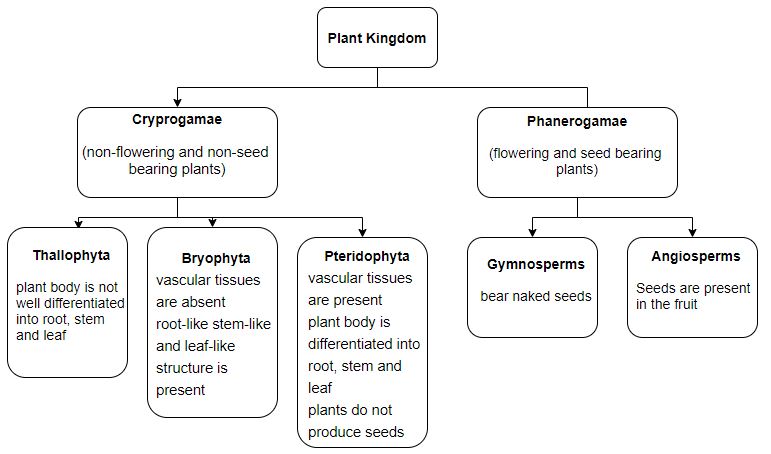
For More Information On the Classification of Plants – Plantae, Watch The Below Video:
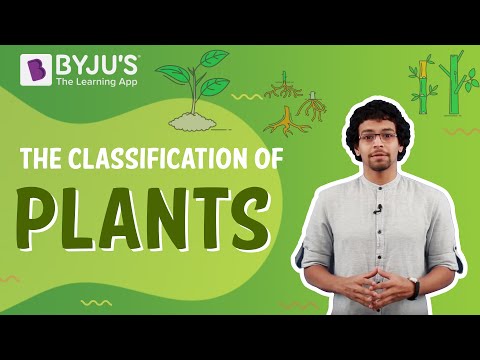
To know more about Kingdom Plantae, visit here.
Cryptogamae
- Cryptogams literally mean ‘plants with hidden reproductive parts’
- Cryptogams are plants that produce spores to reproduce instead of seeds.
- So these plants do not have flowers or fruits.
- Cryptogams are further classified as thallophytes, bryophytes and pteridophytes.
Phanerogamae
- Phanerogams are plants that produce seeds for reproduction.
- Some of them do not produce flowers, while the others produce flowers.
- Phanerogams are further classified as gymnosperms and angiosperms.
Thallophyta

- Thallophyta is the first division of the plant kingdom.
- It consists of red, green and brown algae.
- They don’t have a lot of differentiated structure.
- Examples are Spirogyra, Ulothrix, Cladophora, Ulva and Chara.
Know more: Thallophytes
Bryophyta
- Bryophyta is the 2nd division of the plant kingdom.
- These are the first plants to have differentiated roots and shoots.
- Examples are Funaria and Marchantia.
Know more: Bryophyta
Pteridophyta

- Pteridophyta is the 3rd division of the plant kingdom.
- These plants have proper differentiation of roots, stems and leaves.
- Examples of pteridophytes are Marsilea, ferns and horsetails.
Know more: Pteridophyta
Gymnosperms
- Gymnosperm stands for naked seed.
- They are the first phanerogams since they produce seeds, which are not enclosed in a fruit.
- Examples are pines and deodar, cycas, etc.
Know more: Gymnosperms
Angiosperms
- Angiosperm is the last division of the plant kingdom and has what scientist assume, is the most evolved organism on the planet.
- They bear flowers and fruits, inside which the seeds are found.
Know more: Angiosperms
Watch the video below to learn about the difference between Angiosperms and Gymnosperms:

Cotyledons
- Cotyledons are structures present in seeds for nutrition during germination when leaves are not yet developed.
- Angiosperms either have two cotyledons making them dicots or only one, making them monocots.
Know more: Cotyledons
Dicots and Monocots
- Angiosperms, the highly evolved plants on the planet Earth, are further classified based on the number of cotyledons their seeds have.
- When seeds have two cotyledons, they are called dicots.
- Dicots have a tap root system and reticulate venation. Examples: Mango, Pea, Beans, etc.
- If seeds have only one cotyledon, they become monocots.
- Monocots show a fibrous root system and parallel venation.
- Examples: all grains like wheat, maize, rice etc.

Also read: Difference Between Monocotyledon and Dicotyledon
Kingdom Animalia
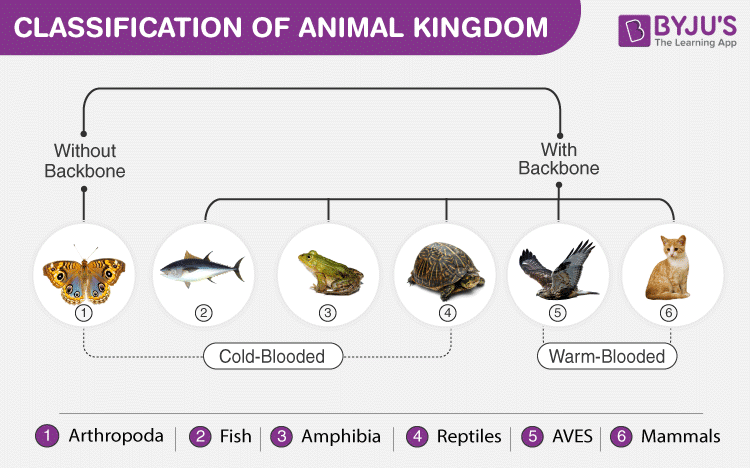
Animalia
- Kingdom Animalia is made up of eukaryotic, multicellular, heterotrophic organisms.
- Mode of nutrition is holozoic and they are either herbivores or carnivores.
- Most animals are motile, they can move independently in search of food, shelter or mate.
- Animals are made up of many organ systems, that aids in performing specific functions that are necessary for the survival of the organism.
- Most of the animals are bilaterally symmetrical, while primitive animals are asymmetrical and cnidarians and echinoderms are radially symmetrical.
Porifera
- This phylum consists of the sponges.
- They are mostly marine, very few are freshwater.
- All the animals are sessile (fixed in one place).
- Cells are loosely arranged (cellular grade of the organization).
- Animals are diploblastic with outer ectoderm and inner endoderm held with jelly-like mesoglea.
- Exoskeleton in the form of spicules made up of silica or calcium carbonate.
- Sponges have pores all over the body. Body pores are called Ostia.
- Water from outside enters the body through Ostia and leaves through one large opening called the osculum.
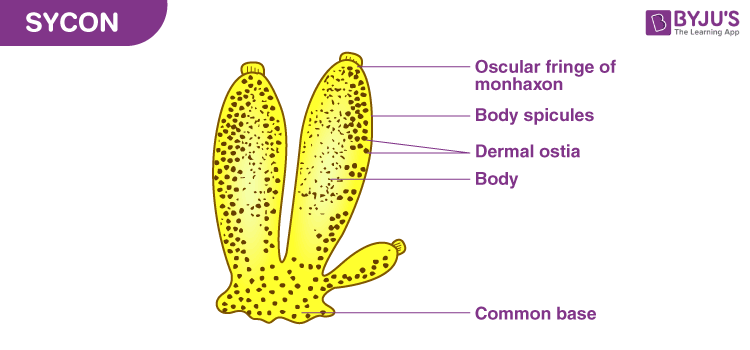
Know more: Porifera
Coelenterata
- These animals are aquatic, mostly marine.
- They are solitary or colonial. Each individual is known as zooid.
- Animals are radially symmetrical.
- Sessile forms are called Polyps and free-living forms are called Medusa
- Cells are organized into tissues (tissue grade of the organization).
- Animals are diploblastic, outer ectoderm and inner endoderm. Mesogloea separates these two layers.
- The body has a single opening called a hypostome surrounded by sensory tentacles.
- Body cavity (coelom) acts as gastrovascular cavity i.e. coelenteron.
- special types of cells called Nematocysts are present for capturing and paralyzing prey, present in tentacles.
- Examples: Hydra, Jellyfish, Corals, Obelia, Sea-anemone.
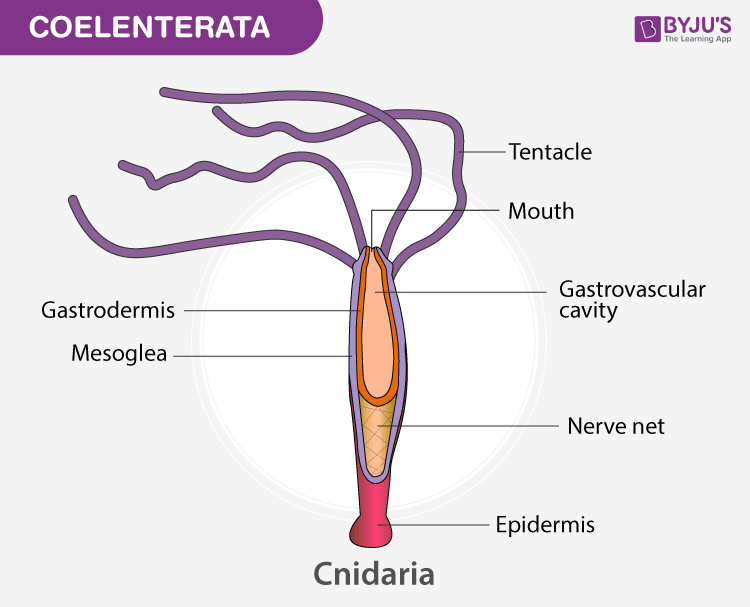
Know more: Coelenterata
Platyhelminthes
- This phylum consists of the organisms that are bilaterally symmetrical, triploblastic and flattened.
- Organ- system grade of the organization is seen.
- Animals are triploblastic with outer ectoderm, middle mesoderm and inner endoderm.
- Acoelomate i.e No body cavity.
- The digestive system is incomplete or absent.
- Mostly parasites, a few are free living.
- Examples: Liver fluke, Tapeworm.
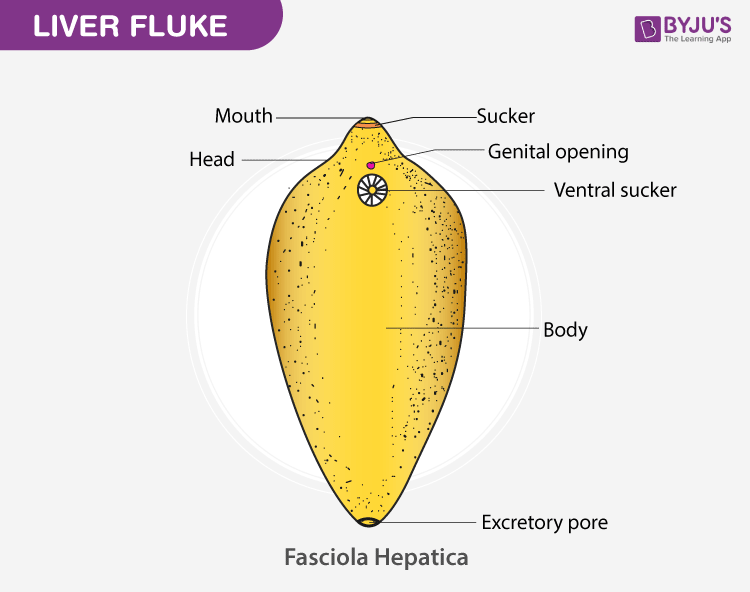
Know more: Platyhelminthes
Nemotoda
- These organisms have bilaterally symmetrical, triploblastic and cylindrical body.
- Organ system grade of the organization is seen.
- Pseudocoelom is present.
- Have a tubular digestive system with openings at both the ends.
- They are endoparasites.
- Mouth is provided with hooks and suckers.
- Examples: Ascaris, hookworm, filarial worm, etc.
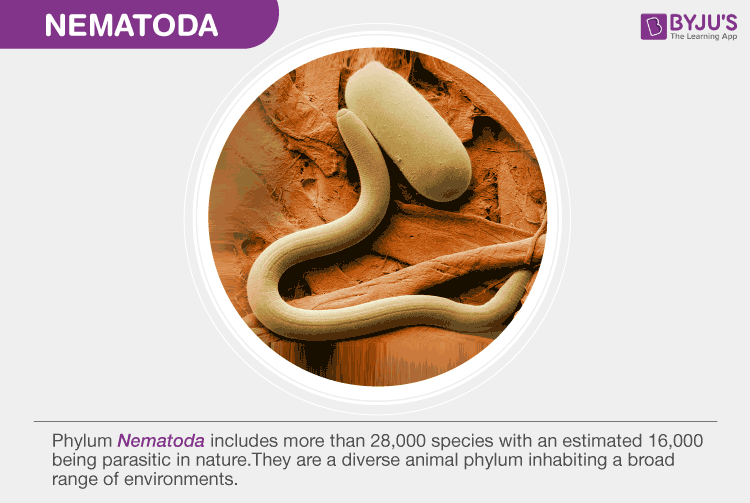
Know more: Nematoda
Annelida
- These organisms have bilateral symmetry and triploblastic.
- They are mostly aquatic, few are terrestrial.
- These are the first organism to have a true coelom.
- Coelome is compartmentalized by intersegmental septa.
- Body long and metamerically segmented (segmentation from outside and inside of the body).
- Examples: leech, earthworm, etc.

Know more: Annelida
Arthropoda
- This is the largest phylum with 80% of all known living animals.
- Animals with jointed appendages (in Greek Arthron: jointed, poda: legs).
- The body has three segments/regions as head, thorax and abdomen.
- Body is covered by an exoskeleton made of chitin.
- They are bilaterally symmetrical and have an open circulatory system.
- Compound eyes are present
- Examples: insects, scorpions, spiders, millipedes, centipedes, crabs, lobsters, etc

Know more: Arthropoda
Mollusca
- They are bilaterally symmetrical, with a reduced coelomic cavity and little segmentation.
- They have an open circulatory system and kidney like organs for excretion.
- Body is soft and usually enclosed in a shell. The shell may be external or internal.
- They show the presence of Foot, Mantle and Mantle cavity.
- Examples: pearl oysters, bivalves, sepia, octopus, snail, slug, etc.

Know more: Mollusca
Echinodermata
- They are spiny-skinned and free-living, exclusively marine.
- The animals are usually pentamerous.
- They are triploblastic and have a coelomic cavity.
- They have a water-driven tube system for moving forward.
- Examples: starfish, sea urchin, sea cucumber, sea lily, etc.
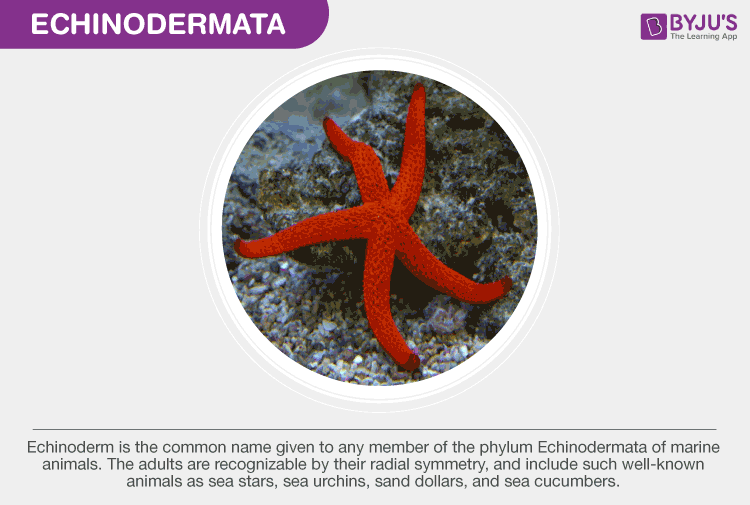
Know more: Echinodermata
Hemichordates
- Hemichordata is bilaterally symmetrical and triploblastic.
- In addition to these, they have a notochord that runs along the back of the animal and separates the nervous tissue from the gut.
- They are marine animals and bridge non-chordates to chordates.
- Porifera to Echinodermata are non-chordates/invertebrates.
- Example: Balanoglossus, also called acorn worm.
Also check: Protochordata
Chordata/Vertebrata

- Presence of dorsal, tubular, hollow nerve cord.
- Presence of notochord.
- Presence of pharyngeal gill slits.
- Presence of post-anal tail.
- Bilaterally symmetrical body.
- Presence of three germ layers.
- Organ-system level of organization.
- Presence of ventral heart and hepatic portal system.
- Presence of well-developed endocrine glands
- Except for a few primitive forms, the animals have a vertebral column instead of a notochord. These animals are called vertebrates.

Know more: Chordata
Pisces
- Class Pisces include all bony and cartilaginous fishes.
- They are exclusively aquatic.
- Body is streamlined with paired and unpaired fins.
- These are cold-blooded vertebrates.
- Heart is two-chambered.
- Lateral line system is well developed.
- Examples: Sharks, Rays, Rohu, Mrigal, Green carp, etc
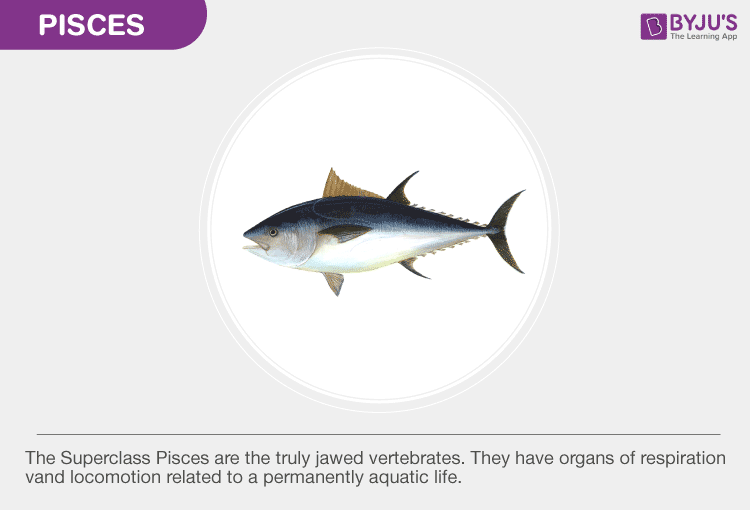
Also read: Pisces
Amphibia
- Amphibians live both, on land and in water and lay their eggs in water.
- Respiration is through gills in the larval stage and through the lungs in adults.
- They are cold-blooded animals.
- They have a three-chambered heart.
- Examples: frog, toads, salamander, etc
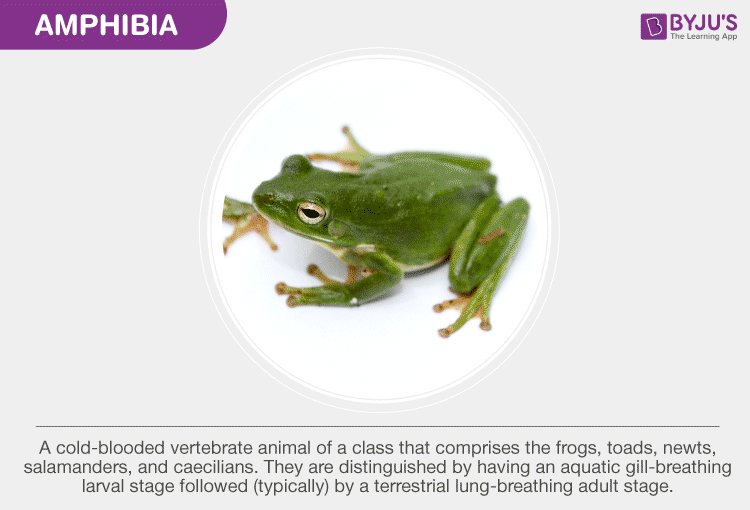
Know more: Amphibia
Reptilia
- These are the first completely land animals.
- Reptiles are cold-blooded and breathe through their lungs.
- They have a three-chambered heart (except crocodile) and lay eggs with tough coverings.
- Body is covered with scales, scutes or hard plates.
- Examples: snakes, crocodiles, turtles, lizards etc.

Also read: Reptilia
Aves
- All birds belong to this class.
- They are warm-blooded, have a four-chambered heart and breathe through lungs.
- They have their forelimbs modified into wings which help in flight.
- Jaws are modified into beaks.
- Bones are hollow and most of them are fused to reduce body weight.
- An exoskeleton is in the form of feathers.
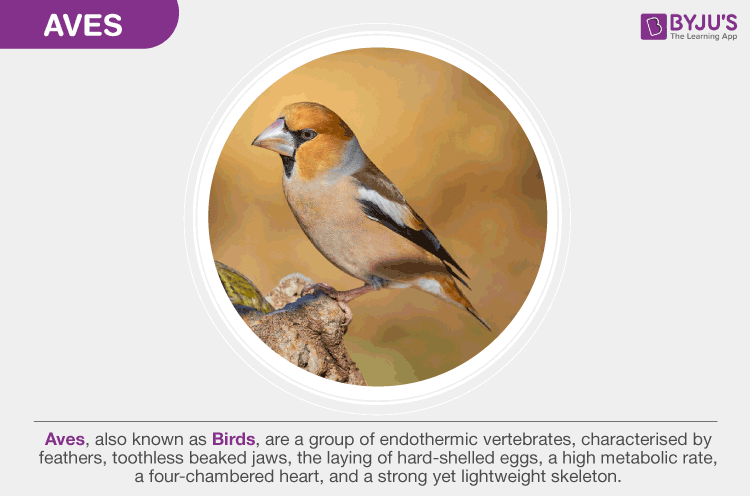
Know more: Aves
Mammalia

- They are warm-blooded, breath through their lungs and have a four-chambered heart.
- Presence of hair on their body, sweat and oil glands are exclusive characters of mammals.
- Presence of pinna i.e external ear is also seen only in mammals.
- They also have mammary glands to feed their young ones.
- They usually give birth to live young ones.
- Examples of mammals: humans, cattle, whales, horses, bats, rats, etc
To know more about Kingdom Animalia, visit here.
Also Check:
- Tissues Class 9 CBSE Notes – Chapter 6
- Motion Class 9 CBSE Notes – Chapter 8
- NCERT Solutions Class 9 Science Chapter 7
- NCERT Exemplar Solutions Class 9 Science Chapter 7
- Important Questions for CBSE Class 9 Science Chapter 7 – Diversity in Living Organisms
- CBSE Class 9 Maths Number System Notes
- CBSE Notes Class 9 Geography Chapter 1 India – Size and Location
Frequently Asked Questions on CBSE Class 9 CBSE Biology Notes Chapter 7: Diversity in Living Organisms
What is ‘Taxonomy’?
Taxonomy is the science of naming, describing and classifying organisms and includes all plants, animals and microorganisms of the world.
What does ‘Gram-positive bacteria’ mean?
A bacteriologist named Christian Gram created a test that could determine if a bacterium had a thick, mesh-like membrane called peptidoglycan. Bacteria with thick peptidoglycan are called gram-positive.
What is a ‘Marine Sponge’?
Marine sponges are sessile animals that look like plants. They attached themselves to a rock, shell or seafloor when they are young and there live for the rest of their lives.
Comments